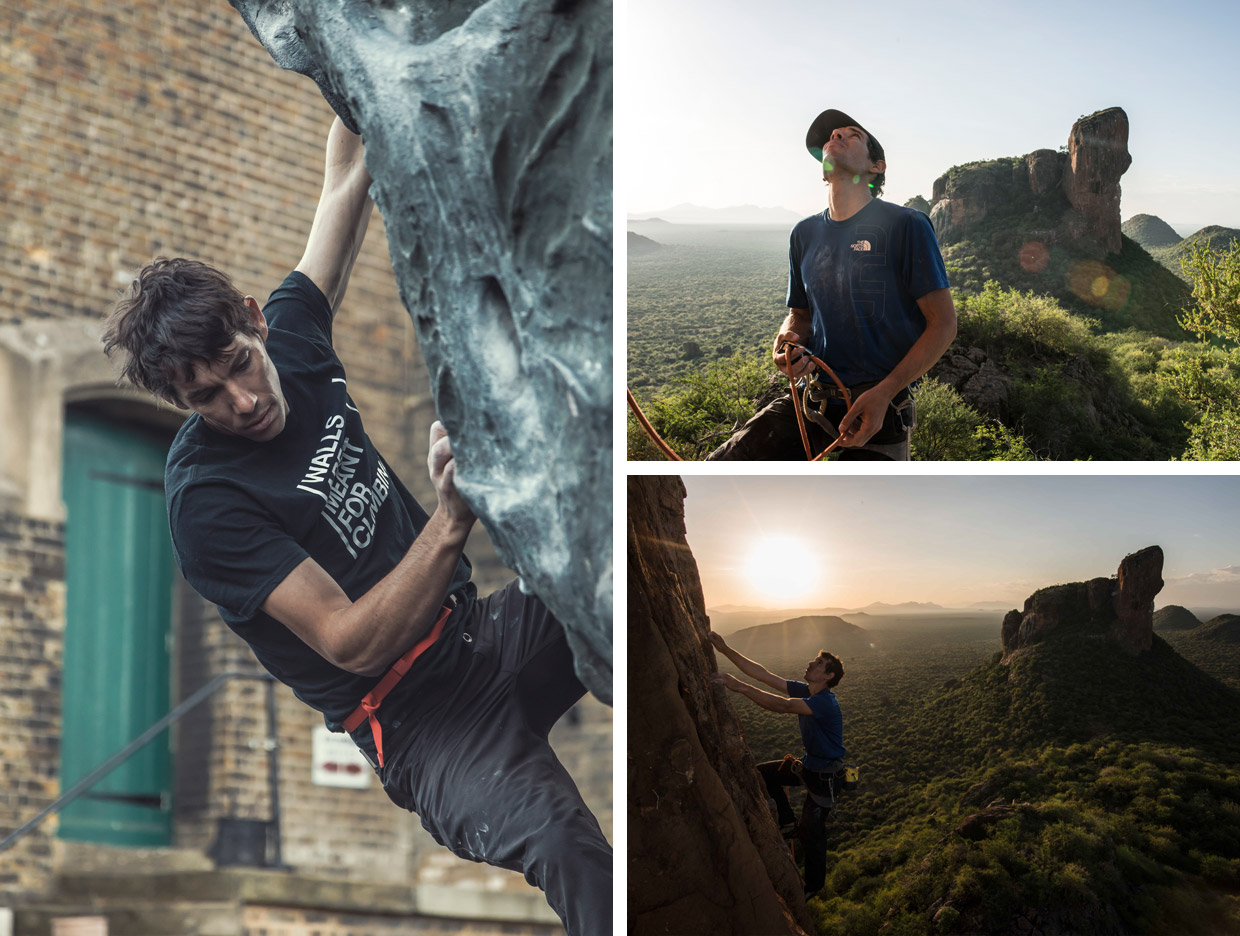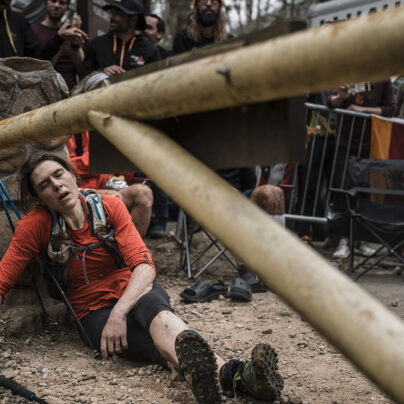No Big Deal – Alex Honnold
Inspiration Photo: ©Renan Ozturk
Photo: ©Renan Ozturk
Written by Hugh Francis Anderson
‘How to get the best of it all? One must conquer, achieve, get to the top; one must know the end to be convinced that one can win the end, to know there’s no dream that mustn’t be dared.’ It may be almost a century since George Mallory penned these words, yet there’s a resonance in them that strikes a familiar and poignant tone. I can’t help but imagine what it feels like to climb to the limits of possibility, to carve a new frontier in a world so explored. Yet frontiers are being forged, and as I approach the Castle Climbing Centre in Stoke Newington, I’m aware that there’s a man inside doing just that. His name? Alex Honnold.
At just 32 years old, Honnold has risen to the pinnacle of climbing fame, and holds a hallowed position as one of the most accomplished living climbers in the world. He climbs in another realm altogether, as the master of ropeless, free-solo ascents of some of the most technical climbs on the planet. In 2008, Honnold tackled two of the most challenging free-solo climbs in the USA: the Northwest Face of Half Dome in Yosemite National Park, and the Moonlight Buttress in Zion National Park. These climbs propelled him into the mainstream world of adventure climbing, and his rise has been monumental since. In 2017, Honnold achieved what most claimed to be impossible: free-soloing the 3,000ft Freerider route on Yosemite’s El Capitan, a feat that has garnered him worldwide acknowledgement both in and out of the climbing community.
When I finally put eyes on the man, he’s 10ft above me on a climbing wall, clinging onto a hold with just two fingers. He glances down at the people below and smiles; he’s in his element. His body is slight, and the sinews in his muscular arms flex as he scrambles back down the wall. ‘Hey man,’ he says, as if we’re already friends.

Honnold tells me how he first got into climbing. He was born and raised in Sacramento, California. ‘As a kid, I always liked climbing. I was always climbing trees, buildings and structures like this,’ he says, pointing around the climbing centre, a converted Victorian water-pumping station. ‘But when I was 11, a climbing gym like this opened in my hometown, so my parents took me in there and I started climbing indoors pretty much all the time. I spent about eight years climbing in the gym.’
I asked him how he transitioned into climbing outdoors. ‘As a teenager, I started doing excursions outside with friends. On school holidays, I’d go to some of the areas around California and spend a couple of days climbing outside, but I was still limited with no car and no driving licence, no equipment and no real knowledge.’ He laughs. ‘And then when I was 19 I dropped out of university, where I studied engineering for a year, and started climbing outdoors full-time. I didn’t really care about engineering, and I was climbing all the time anyway, so it made sense.’
It was then that Honnold began a nomadic existence, first travelling the States in his mother’s minivan, before buying his own van, which he has now lived in for over 10 years. I wonder if this nomadic existence is a lonely one.
‘It’s interesting because I was on my own a lot, but now it’s the opposite. I have such a big community all over the world, and know so many climbers. There’s such a big group of climbers who are travelling all the time. But certainly, when I started climbing full-time, it was quite insular.’
As a free-soloist, solitude must still play a large role in the preparation for climbs. The level at which Honnold has to perform must be nothing short of 100%, especially when faced with certain death should things go wrong. ‘Yes, I think it’s fair to say that solitude helps for the free-soloing, for climbing by myself – it certainly helps to have time alone to process and think about the climbs. The high consequences and the chance of death if you make a mistake do contribute to the experience because it requires you to perform at a higher level.’
I mention that I suppose the sense of fear plays a large role when free-soloing too. ‘The fact that it’s testing you is definitely part of it,’ Alex confirms. ‘I’m trying to avoid fear through preparation, by spending time making sure I’m ready. Ideally, I’m not experiencing fear while I’m up there, and when I solo free-climb, I’m not scared at all. But the consequences do matter, and do add to the experience.’
I’m trying to avoid fear through preparation, by spending time making sure I’m ready. Ideally, I’m not experiencing fear while I’m up there, and when I solo free-climb, I’m not scared at all. But the consequences do matter, and do add to the experience.’

As the world sees a boom in social media addiction, in which extreme sports and adventure travel play an enormous role, I’m unsure of where a sport like free-soloing sits. I ask Alex for his thoughts. ‘It’s interesting because it’s easy to lump them together as “extreme”, but it’s actually a totally different sensation. I’ve skydived and done various “extreme” sports before, and even mountain biking feels more extreme to me. The thing with soloing is that it’s not fast at all, it’s very slow; you have to consciously and deliberately choose to move over and over, whereas in downhill skiing, mountain biking and a lot of other sports, once you commit to a line, you’re going one way or the other. In climbing, you never get a rush like that due to the slow, calculated movements. So, it doesn’t feel like other extreme sports, even though from the outside it seems outrageous.’
And outrageous it is. For his El Cap climb, Honnold faced 2km of vertical climbing with no support, ropes or safety net. If you make a mistake, you die. So how do you train for something of this magnitude?
‘I climbed and planned it over and over. I memorised numerous moves and I practised the climb in different styles and ways to see what would feel most secure when ropeless,’ he says. ‘When you climb with rope, there are many things you can do that are physically easier, but are very insecure, so if your foot slips and you fall, you’ve got support so you’re OK. It means that you climb in the most efficient way possible. But without a rope, the efficiency doesn’t matter as much – you want to make sure you feel secure, because if a foot slips, you’re going to fall. There were whole sections of the route that I climbed totally differently because it felt safer.’
Yet Honnold still appears utterly unfazed by the very concept of fear, and by the way he recounts his El Cap climb, it’s easy to understand why he’s garnered the nickname ‘No Big Deal’. In fact, Honnold was part of a 2016 neurological study to determine the fear levels of adventure sportsmen, and his results showed a man with an abnormally low sense of fear; it’s just the way he is. And how did it feel to reach the summit? ‘I was pretty euphoric,’ he says casually. ‘It was something I had dreamed about for years, and I’d put a lot of work into it, which was hard. I’d also built it up in my mind as a big thing, so to finally do it was pretty moving and I was delighted.’
Before long, Honnold is getting pulled away for a photoshoot with The North Face for a new ‘Walls Are Meant For Climbing’ initiative, so I ask him one final question, and one that intrigues me the most. What is it that you love most about climbing?
‘What I love most about climbing is the actual movement, swinging around, dangling from holds; it feels like playing, and it’s always felt like playing. Humans are hardwired to appreciate the outdoors and to enjoy nature and open spaces, so it all comes together with climbing. You get to be with your friends in the most beautiful places on Earth whilst doing something that’s super fun to do, and I think that’s pretty awesome.’
I’m reminded once again of George Mallory, who when asked why he wanted to climb Everest, muttered just three words: ‘Because it’s there’. I feel Honnold embodies much of the same spirit, a spirit that knows no bounds.
For more about Alex Honnold, visit: alexhonnold.com or find him on Instagram @alexhonnold, Twitter @AlexHonnold and Facebook /AlexHonnold
Written by Hugh Anderson
Website: hughfrancisanderson.com
Instagram: @hughfrancisanderson




